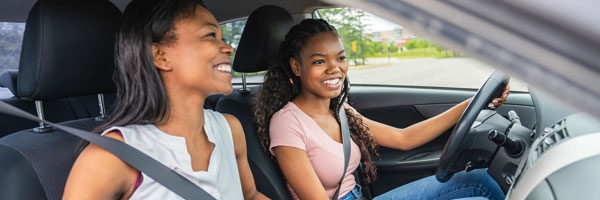
Many of us are aware of the dangers of distracted driving – we’ve heard the statistics, why it’s unsafe and that it should be avoided. For new drivers specifically, the risks associated with distracted driving can sometimes be brushed off or underestimated.
Safe driving requires full attention on the road and any activity not related to driving is a distraction that increases the risk of crashing. Knowing the risks of distracted driving and tips to avoid it is an important lesson, especially for teen drivers.
What is distracted driving?
Safe driving requires visual, manual and cognitive attention being focused on the road ahead. Distracted driving occurs when one of these functions is preoccupied by something other than driving.
Visual
Visual distractions mean engaging in anything that takes your eyes off the road. Some examples of visual distractions include:
- Adjusting the radio or climate controls
- Looking at your cell phone
- Turning to look at a passenger while speaking with them
- Watching an accident scene as you drive by
Manual
Manual distractions refer to the driver taking their hands off the steering wheel, decreasing their control over the vehicle. Manual distractions can include:
- Adjusting your radio or climate controls
- Texting or talking on your cell phone
- Eating, drinking or putting on makeup
- Searching for an item inside your car, such as your wallet
Cognitive
Cognitive distractions occur when the driver’s mind is not focused on the road. These types of distractions may be less apparent and easier to fall victim to – drivers often don’t realize they aren’t paying attention until it’s too late. Some common types of cognitive distractions are:
- Drowsiness
- Daydreaming
- Emotional stress or crying
One of the most dangerous forms of distracted driving is cell phone use, as it involves visual, manual and cognitive distractions. While we usually think of cell phone use being specific to texting, this may also include posting to social media, talking on the phone or using a navigation system.
According to the National Highway Traffic Safety Administration, engaging in these activities takes a driver’s eyes off the road for an average of 5 seconds – when traveling at 55 mph, this is equivalent to driving the length of a football field with your eyes closed.
The importance of staying safe on the road
It’s important to take extra precautions to limit distracted driving among teens; as less experienced drivers, they may be more susceptible to distractions on the road. Encouraging them to form safe driving habits early on and educating them on the risks of distracted driving can help them and others arrive to their destination safely. No text or phone call is more important than doing your part to reduce distracted driving accidents.

Learn about our
Auto Insurance
Tips to reduce distractions
Some of the most important ways to limit distracted driving among young drivers is to educate them on the risks, reduce opportunities for distractions and encourage them to reduce their speed.
- Education – It’s important to have a conversation with your teen about distracted driving and risks it poses to them and others in the car or on the road. Be sure to share facts and statistics about the dangers of distracted driving, while also sharing tips to avoid distractions.
- Remove potential distractions – Encourage teens to finish any calls or texts before starting the car. Ensure they know how to get to their destination and get any directions they need before taking off. If you know your teen is going to be driving during a certain time, avoid calling or texting them – ask that they check in before leaving or once they arrive.
Some smart phone models have a “do not disturb” setting – this will respond to text with an automated message and will not alert the driver until they have safely arrived at their destination. This is a good way to limit smart phone distractions.
- Reduce speed – An overall way your teen can stay safe on the road is to decrease their speed. This will help them stay safe in bad weather, avoid obstacles and respond to other drivers’ behaviors on the road. Should they become distracted, they will have additional response time when driving at a slower speed.
Additional Safe Driving Tips
You should also consider adding roadside assistance to your policy in case your teen needs help after an accident or auto breakdown.
Contact your local independent agent today to learn more about how Integrity auto insurance can help protect you and your teen driver.
Disclaimer: This article is for informational and suggestion purposes only. If the insurance policy coverage descriptions in this article conflict with the language in the policy, the language in the policy applies.
Sources:
- Teen Drivers Source
- NHTSA
- Drive Safe Online